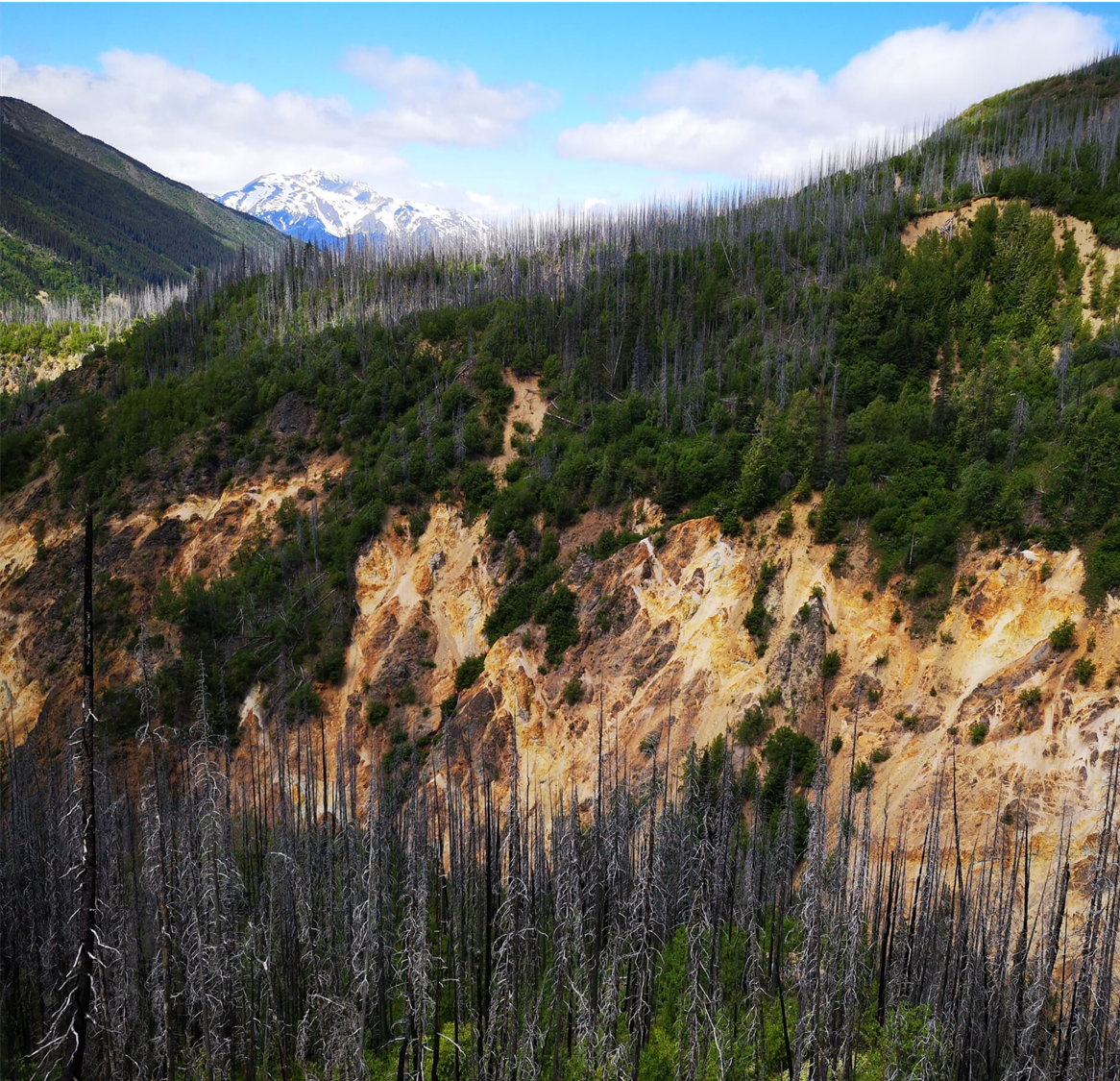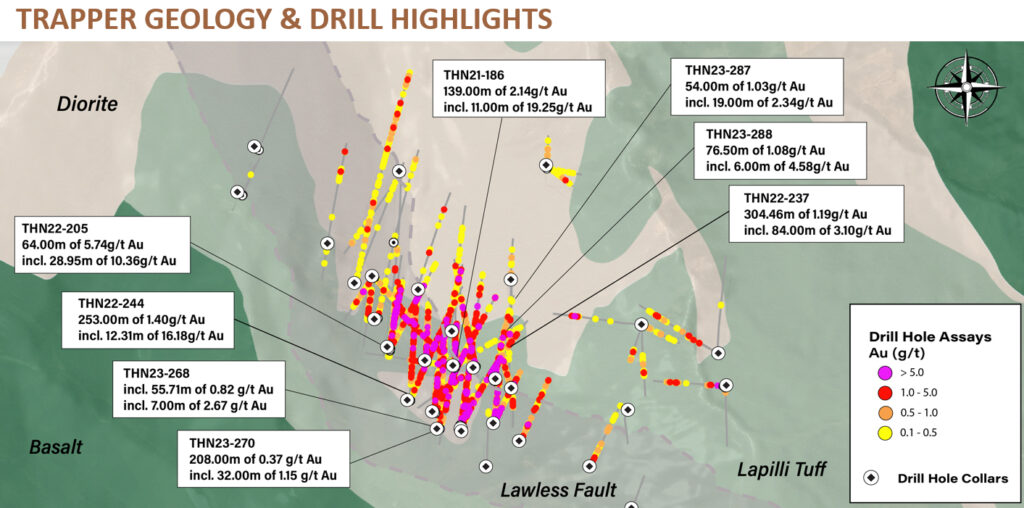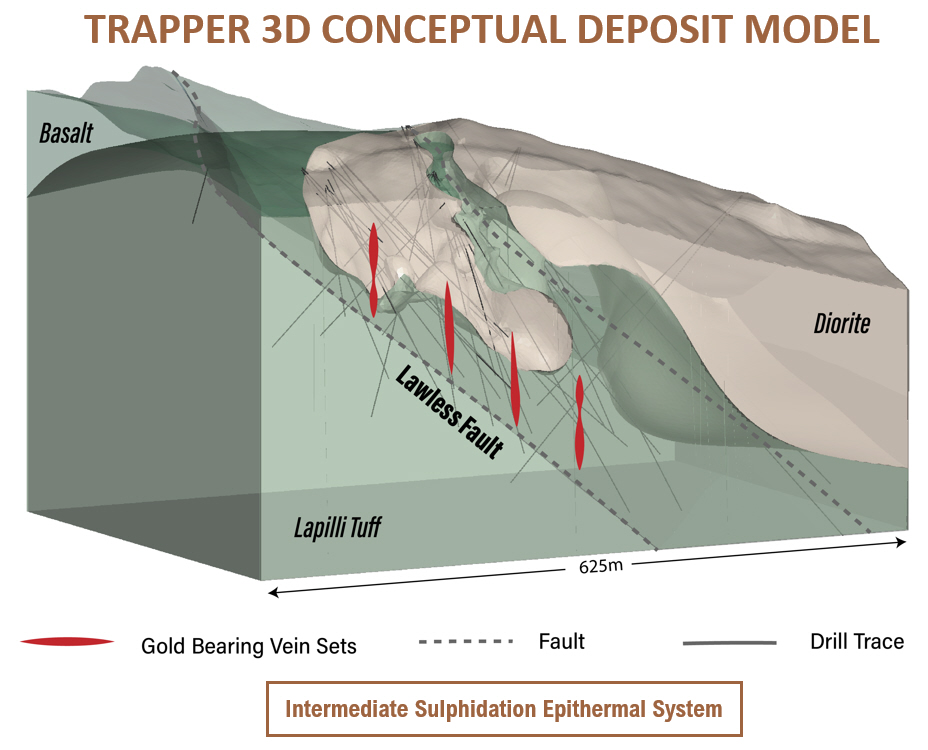Copper-gold-silver-molybdenum porphyry mineralization at the Camp Creek Target has been the focus of drilling by Brixton Metals since 2011. The target area is approximately 1.5km by 2km, and covers several different mineralized zones, including Oban, Talisker and Glenfiddich.

The Camp Creek Target is a Cretaceous-aged, calc-alkalic Cu-Au-Ag-Mo porphyry, with associated high-sulfidation precious metal veins and mineralized diatreme breccias.
The Camp Creek target has been a source of exploration intrigue since the 1950’s, due in part to the large (>1km) alteration system that is evidenced by acid sulfate weathering exposed along the local drainages (photo above). Previous operators and early work by Brixton tested this significant hydrothermal system with shallow drilling, which did not intersect any obvious copper-porphyry mineralization. It wasn’t until 2019, when Brixton drilled THN19-162, that a hole was deep enough to connect with the porphyry veining system, starting approximately 300m below the surface. Through the 2020 to 2023 exploration seasons, drill testing has pushed holes up to 1,600 meter depths and Camp Creek is now encountering Cu-Au-Ag-Mo porphyry mineralization over 100’s of meters, including 1562.35m of 0.19% Cu, 0.05g/t Au, 2.81 g/t Ag and 180 ppm Mo (0.34% CuEq*) in THN23-261, and 821.25m of 0.24% Cu, 0.28 g/t Au, 2.44 g/t Ag and 174 ppm Mo (0.54% CuEq*) in THN21-184. Brixton continues to test the extents of this porphyry system, at depth and towards the northwest, northeast and southeast. Exploration is guided by an evolving geological model, alteration and vein mapping, oriented core data collection, geochemistry and geophysics.
The Camp Creek Target area is characterized by Triassic Stuhini Group metasedimentary rocks, intermediate to mafic volcanic and pyroclastic rocks, intruded by Late Cretaceous quartz-biotite-feldspar porphyry (Thorn Stock) and associated late-stage diatreme breccias and dykes. The Cu-Mo-Au-Ag porphyry mineralization at Camp Creek is hosted within the Thorn Stock and surrounding Stuhini Group metasedimentary rocks. Based on visual logging and geochemical interpretations, the Thorn Stock can be subdivided into: Porphyry V, Porphyry Z, Porphyry Y, and Porphyry X. The Windy Table Cretaceous volcanic and pyroclastic rocks overlie the Thorn Suite at upper elevations at Camp Creek, with associated unmineralized felsic and intermediate dykes.
Mineralization assemblages are dominantly comprised of chalcopyrite, pyrite, and molybdenite present within porphyry-style quartz and quartz-anhydrite veins as well as disseminated sulphides. Mineralization at depth is associated with potassic alteration and high-grade mineralization is preferentially hosted within Porphyry X, a crowded plagioclase porphyry with stacked biotite. Triassic Stuhini Group metasediments and volcanic rocks that have been intruded by the Thorn Stock are also well mineralized, especially when proximal to Porphyry X.
The Trapper Gold Target is a complex, structurally controlled, high-grade gold system located 7 kilometers south-southeast of the Camp Creek porphyry target. Drilling has defined the gold mineralization over 500 meters strike length. At surface, the Trapper Target is expressed as a 4km northwest trending gold and zinc soil geochemical anomaly.

Brixton acquired the Trapper Gold Target in late 2020 and has drilled 18,850 meters with 79 holes, in addition to the 42 holes and 8,500 meters drilled by Ocean Park in 2011. Brixton’s initial drill program in 2021 intersected 2.14g/t Au over 139 meters in hole THN21-186, with a 64m intercept of 5.74 g/t Au from hole THN22-205 the following year. The 2023 drill campaign at Trapper was designed to test the extents of the main mineralized corridor along the Lawless fault zone, as well as testing step-out targets where similar structural and geophysical features were interpreted using the high-resolution aeromagnetic survey completed in 2022. Results from the 2023 drill program demonstrated the potential for broad intercepts of near-surface gold mineralization, including 76.50m of 1.08g/t Au in THN23-288.
While Trapper is largely undercover, the gold-in-soil geochemical footprint extends 4km by 1.5km and remains largely undrilled. High-grade surface grab samples have returned assays up to 152 g/t Au along Inlaw Creek, over 500m away from the focused drilling area. Drilling will continue in 2024 to test and define the scale potential across the Trapper Gold Target. Field work focussed on geological mapping, including alteration, veining and structural details, and continued rock and soil sampling will be the key to generating new drill targets within the Trapper area.
The Trapper Target is predominantly intermediate to mafic volcanic and volcaniclastic rocks of the Upper Triassic Stuhini group, which are intruded by Cretaceous quartz diorites, interpreted as part of the Thorn Magmatic Suite.
Gold mineralization at Trapper is structurally controlled along the Lawless fault, trending northwest-southeast and dipping moderately to the north. Mineralization appears to favour the contact between the Cretaceous (85.2 +/- 1.2Ma) quartz diorite and the Triassic lapilli tuffs with broad gold intervals largely hosted along the faulted contact. The gold is associated with silver and base metal sulphide quartz-carbonate veins, containing pyrite-galena-sphalerite +/- chalcopyrite +/- bornite, occurring conjugate to the Lawless fault. Dozens of visible gold occurrences have been observed within the mineralized veins and examples are documented under the Core Photos tab.


Metla is a large 7 km x 6km alkalic porphyry target area that includes highly anomalous copper, gold and silver values in rocks at surface, hosted predominantly by Upper Triassic Stuhini Group rocks. Metla is 20 kilometers southeast of Camp Creek.

Brixton acquired the Metla Target claims in 2020. The area has been explored intermittently since the 50’s, with most of the work completed by Comino in the 1980’s, and by multiple operators in the early 2000’s. Historical work at Metla focused on Pb-Zn-Au mineralized hydrothermal breccias around the Metla Creek area where trench sampling by Cominco in 1989 returned values of up to 4.6 g/t gold over 9 meters. A small diamond drill program was completed in 1991 as a follow-up to Cominco’s earlier groundwork, although no significant mineralization was intersected.
Glacier retreat within the last few years has uncovered new outcrops and Brixton has strategically targeted these exposures. Prospecting in 2022 identified several new copper and gold-rich occurrences, one of which had grab assays up to 32.8% Cu and 59.8 g/t Au and warranted drill testing with drill holes THN22-232 to THN22-236. Drilling intersected variable amounts of potassium feldspar, epidote and hematite alteration with local disseminated pyrite and trace chalcopyrite and bornite. Later in the season a new Au-Ag-Cu showing was found at surface with one sample assaying 34.9 g/t Au, 1,110 g/t Ag and 16.65% Cu, with surrounding samples assaying 33.2 g/t Au and 25.1 g/t Au. Prospecting in 2023 continued to expand the anomalous Cu-Au-Ag area, including a previously unsampled quartz vein with 52.5g/t Au and 116 g/t Ag, a massive sulphide sample with 12.95% Cu, and a base metal vein with 4,120 g/t Ag, 9.02 g/t Au and 1.16% Cu. Surface sampling and mapping will continue to evaluate the Metla Target in 2024.
The Metla Target area consists of Paleozoic Stikine Assemblage metasedimentary rocks (and lesser mafic volcanic rocks), with Middle to Late Triassic weakly foliated quartz diorite (220 +/- 3.1 Ma) and Sloko Group bimodal volcanic rocks. The Metla area is bordered to the northwest and southern extents by Paleocene to Eocene Sloko-Hyder granite, quartz monzonite, granodiorite and alaskite. The Paleozoic rocks are a variably folded and weakly metamorphosed sequence of clastic rocks with local chert and limestone. Near Metla Creek and throughout the northern area of Metla, a hydrothermal breccia is common and occurs in meter-scale outcrops and centimeter-scale veins. The breccia is generally matrix supported with polymictic, subangular, poorly sorted sedimentary and volcanic fragments in an amorphous silica ± carbonate ± pyrite matrix and locally hosts gold mineralization.
Historically, the focus at Metla has been on the hydrothermal breccias with sulphide cement and semi-massive sulphide veins. Sulphide mineralization in the hydrothermal breccia and semi-massive sulphide veins occur predominantly near the contact of the metasedimentary and mafic pyroclastic units adjacent to Metla Creek. Sulphides include pyrite, galena, chalcopyrite, and sphalerite. Recent exploration has expanded to examine the copper and gold systems hosted within quartz-potassium feldspar veins hosted by the Triassic foliated quartz diorite. These veins are commonly associated with bornite, chalcocite, and rare visible gold, resulting in exceptional grades. In the southwest portion of the Metla claims recent reconnaissance sampling in 2022 and 2023 returned multiple high-grade polymetallic Au-Ag veins assaying up to 52g/t Au and 4120 g/t Ag hosted in the Triassic quartz diorite. Veins throughout the area exhibit a distinct association with highly anomalous Bi-Te and W-Mo reflecting the potential for a reduced-intrusion-related gold system in the area.
Outlaw is a clastic sediment-hosted gold zone that is constrained by stratigraphy and structure. The target is associated with a gold-in-soil anomaly over 4 kilometers long and is located 3.5km southeast of the Camp Creek Cu-Mo-Au-Ag porphyry system.

The Outlaw Gold Target was first tested by Chevron in the early 80’s with trenches and soil sampling, which identified a >2km long Au-in-soil anomaly associated with a series of galena-arsenopyrite-pyrite quartz veins. Small drill programs followed and limited work was done until Brixton acquired the ground in 2010. Brixton’s expanded soil grids demonstrated that the gold zone was continuous over 4 kilometers and diamond drilling confirmed that the gold-bearing horizon occurs at depth, continuous over a 600m strike length with grades up to 1.15g/t Au over 59.65m in hole THN14-128. Gold mineralization is controlled by preferential stratigraphic units and structural pathways. The Outlaw Gold Target remains open along strike to the east and west.
The Outlaw Target area is composed of metasedimentary rocks that most frequently overlie Triassic Stuhini Group mafic pyroclastic rocks, both of which are intruded by Cretaceous felsic dykes (84.84 +/- 0.48Ma). At higher elevations at the north end of the target area, a Late Cretaceous granodiorite stock (Windy Table) intrudes the fine-grained clastic metasedimentary rocks and lesser marble. The clastic rocks are metasiltstones and quartzite with lesser metasandstone. Even though the maturity, degree of metamorphism, and folding of these metasedimentary rocks is more consistent with the Stikine Assemblage, the rocks overlie mafic pyroclastic rocks and contain carbonate rocks which makes them more consistent with the upper Stuhini Group.
The dominant alteration assemblage observed at the Outlaw Zone consists of illite, silica (as broad hornfels), quartz stockwork and veinlets, actinolite and carbonate, locally associated with kaolinite.
The mineralization is hosted predominately within interbedded siltstone and greywacke, especially when proximal to felsic dykes. These felsic dykes generally trend east–west, though their orientation and extent are largely inferred from topographic lineaments. Primary sulphides are pyrrhotite and pyrite which occur as semi-massive replacement to disseminated styles, as well as veinlets, and lesser sphalerite +/- chalcopyrite and tetrahedrite disseminations and veinlets. Gold mineralization correlates with silver, lead, arsenic, antimony, tellurium, and bismuth.
The North Target covers the region 5 to 14 km north of Brixton’s Thorn Camp, northwest of the Sutlahine River. The area is underlain by Late Triassic Stuhini volcanic rocks and Jurassic aged volcanic and sedimentary rocks of the Laberge Group, intruded by several Cretaceous and Eocene quartz feldspar porphyry dykes and sills. Three large gossans have been observed within the target area with strong sericite-pyrite alteration. Anomalous Au-Ag-Cu-Pb-Zn has been sampled across this large area, associated with skarn, porphyry, polymetallic veining and sedimentary-hosted mineralization settings. A 20cm chip sample collected in 2004 assayed 13.35 g/t Au and 324 g/t Ag. The North Target area has not yet been drill tested.
The copper-rich East Target is located 25km east of Metla and 17km north-northeast of the Golden Bear Mine. The geology is dominated by Middle to Late Triassic quartz diorite and granodiorite intrusive rocks, with Stuhini Group volcanic rocks, which are intruded by Late Cretaceous to Tertiary feldspar-biotite porphryries. There are three main copper showings: Bing, Icy and Icy South. The Bing showing is on the east side of the Samotua River and includes widespread copper and molybdenum mineralization, as disseminations and within veining stockworks. Historic drilling in 1965 and 2011 did not target the area hosting the most anomalous samples to the north, where a cluster of 10 samples have grades greater than 2% copper over a 500m x 500m area. Surface rock samples collected in 2022 returned up to 5.79% Cu. Over 200 soil samples were collected at Bing in 2022, and results were promising with 16 samples greater than 1000 ppm Cu and highly anomalous values of 9,610 ppm Cu and 7,290ppm Cu collected at the south end of the zone. The Icy showing is to the west and includes a 2km x 800m gossan with associated copper soil anomaly. Copper values in rocks reach up to 3.62% Cu. Only minimal work has been conducted on this target since RioTinto drilled in 1977. In 2023, Brixton followed-up on a highly anomalous gold value from a heavy mineral concentrate sample collected at Icy South in 1996 and discovered several quartz bornite veins with grab sample results up to 33.3% Cu, 7.04g/t Au & 238g/t Ag and 20.8% Cu, 0.91g/t Au & 149g/t Ag.
The Plum Target is located 8 km east of the Metla Target, immediately west of Tatsamenie Lake. The geology is dominated by Mississippian volcanic rocks of the Stikine assemblage, with local Lower Permian limestone. The aforementioned rocks are intruded by Triassic and Jurassic diorites and covered locally by sub-horizontal Windy Table or Sloko volcanic rocks. Plum is an early-stage porphyry target with multiple areas of highly anomalous indicators of porphyry style mineralization. Copper mineralization is vein-hosted with chalcopyrite and pyrite, including local chalcocite. This mineralization is found within broader zones of silica and pyrite alteration. Grab samples collected in 2023 found multiple occurrences with greater than 1% Cu, including one assay of 12.95% Cu.
The West target is a copper target, located 5km west-southwest of the Camp Creek Target. Geology at the West Target is comprised of Triassic volcanic rocks of the Stuhini Group, and Jurassic argillite and conglomerate of the Laberge Group. These Mesozoic volcanic and sedimentary rocks are cut by an Eocene granodiorite (54.2 +/- 0.8Ma) and alkali feldspar granite batholith of the Sloko-Hyder Plutonic suite, some of which has been locally metamorphosed and migmatites are observed. Mineralization is vein-hosted and disseminated, with porphyry-style quartz-pyrite-chalcopyrite veins in the Eocene intrusive and Stuhini volcanic rocks. With the retreat of snow and ice, a new showing was evaluated in 2023 and 11 samples were collected with greater than 5% Cu, including grab samples with 16.25% Cu and 817 g/t Ag.
The Solstice Target is located approximately 35 km south of the Trapper Target. Geology includes greenstones of the Whitewater Metamorphic Complex, coarse clastic sedimentary rocks of the Stikine Assemblage and Late Triassic quartz diorite intrusive rocks. Known mineralization includes vein-hosted pyrite +/- galena-stibnite and disseminated pyrite and chalcopyrite. Only reconnaissance surface sampling surveys have been completed in the target area to date. In 2023, Brixton field crews worked upstream of one of the highest-grade gold samples in silts from the BC Regional Geochemical Survey, and sampled quartz-pyrite veins (+/- galena-sphalerite-stibnite) with up to 39 g/t Au, including a grab sample with a fleck of visible gold assaying 7.1 g/t Au and 192 g/t Ag.
Val is a copper exploration target that was identified and explored in the 80’s, two kilometers south of the Triassic-Jurassic Red Line, 28 km east of the Trapper Target. This prospect is underlain by Triassic granodiorite, intruded by felsic Sloko Group dykes. Only two small rock and soil sampling programs have been conducted at this location, and prior to Brixton’s acquisition in 2022 no work had been documented since 1987. Rock sampling in 1980 identified a bornite-chalcocite bearing 20cm quartz vein, assaying 35% Cu and 228 g/t Ag. Follow-up sampling by Brixton in 2022 confirmed the presence of the vein with assays up to 40.7% Cu, and a confirmed strike length of over 250 meters. Two copper-bearing, sub-parallel veins were also identified 50m and 100m northwest of the main vein with values of >50% Cu and 45.4% Cu respectively.
The Moly Valley Target is located 7km southwest of Metla. The Moly Valley Target geology is dominated by plutonic rocks, with Middle to Late Triassic quartz-diorites intruded by granitic intrusive rocks of the Sloko-Hyder Plutonic Suite. At surface there are quartz-carbonate-molybdenite-pyrite veins, up to 3m in width that are continuous over 100’s of meters. These mineralized veins are observed over a 2.5 kilometer northwest trend. Sampling in 2023 confirmed the presence of >1% Mo veins on the east side of the target area. Historic sampling demonstrated grades up to 1.45% Mo at the main showing area.
The Tat Cu-Au Target is 4km east of Trapper Lake and 11km east-southeast of the Trapper Target. Triassic Stuhini Group volcanic rocks are unconformably overlain by Jurassic Laberge Group sedimentary rocks. Quartz monzonites are also observed but of unknown age. The Tat Target was first worked in 1991 following the anomalous gold results reported from the BC Regional Geochemical Survey. Prospecting in the last 10 years have outlined a handful of chalcopyrite-pyrite showings with one sample assaying 4.24% Cu, 0.54 g/t Au and 35.1 g/t Ag. Other anomalous grab samples include 3.03% Cu, 1.02 g/t Au and 41.6 g/t Ag, and another at 2.09% Cu, 1.8 g/t Au and 164 g/t Ag. A small diamond drill program was completed in 2018-2019, although no significant mineralization was intersected at depth.
Terr is located along the western slopes of the Sheslay River, 30 km east of the Trapper Target. The area is mapped as predominantly Jurassic sedimentary rocks with Triassic and Cretaceous intrusions. There have only been two small-scale exploration programs reported at Terr, focused on mapping and prospecting. Mapping outlined widespread alteration within the sedimentary and intrusive rocks, associated with mineralized quartz vein samples and assays up to 11 g/t Au.
The GoldBee Target is the southern extension of the Golden Bear Mine trend, a carbonate-hosted gold system with associated silver, copper and antimony. Gold mineralization is structurally controlled and hosted within Upper Triassic Stuhini Group sedimentary rocks. Geochemical surveys and prospecting are planned.
Cirque is a copper porphyry target located over 3 kilometers east of Camp Creek, immediately south of the Outlaw Target. The area is underlain by Late Cretaceous Windy Table volcanic rocks and associated Windy Table Suite Intrusions to the southeast. Using the MDRU Porphyry Index (MPIx) on the local soil geochemistry data, a ratio of proximal and distal elements in a copper porphyry system ([(Cu/10) +Mo+(10xW)+(20xSn)]/[ (5xSb)+(20xTl)+Ag+As+Li]), Brixton Metals has outlined a 1km by 2km anomalous area coincident with the Cretaceous intrusion centers, jarosite and geothite anomalies, and mapped pyrite-chalcopyrite occurrences. To the northwest, a large quartz-sericite-carbonate alteration zone has been mapped with 0.5-2.0% disseminated pyrite throughout. A grab sample from Cirque creek assayed 1.61% Cu, 0.11g/t Au and 12.75 g/t Ag. Follow-up work will continue in 2024.
Trifecta is a copper porphyry target located 1.5 kilometers south-southeast of Camp Creek and 3 kilometers west of Outlaw, in the valley along La Jeune Creek. The area is underlain by Triassic Stuhini volcaniclastic rocks with small Thorn Stock intrusions. Outcrop exposure is limited and this prospective area has been highlighted by soil geochemistry. Using the MDRU Porphyry Index (MPIx), which uses a ratio of proximal and distal elements in a copper porphyry system ([(Cu/10) +Mo+(10xW)+(20xSn)]/[ (5xSb)+(20xTl)+Ag+As+Li]), Brixton Metals has been able to vector into the Trifecta Target and outline a 350m by 600m anomalous area with a coincident mag high anomaly. Within the soil anomaly, rock samples have been collected with up to 4.45% Cu in float and 2.46% Cu in grab samples. Mineralization consists of narrow quartz veining with pyrite and chalcopyrite and associated disseminated pyrite and stringers. Julian Mining completed two small diamond drilling programs at Trifecta in 1963 and 1965, with holes <57m in length and very limited select assaying downhole. Results include 2.4% Cu over 2.38m in JM63-002 and 0.52% over 7.04m in JM63-004.